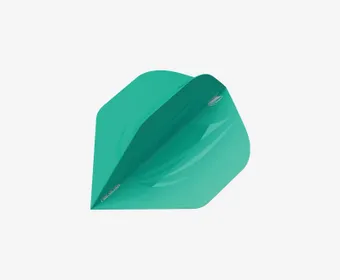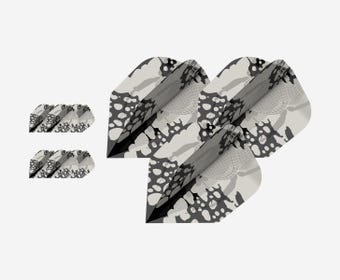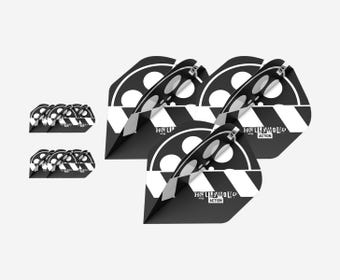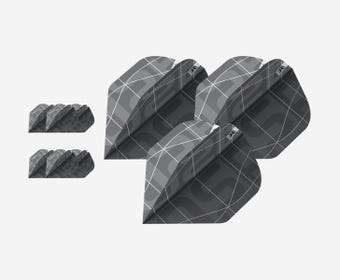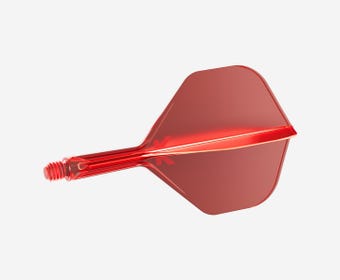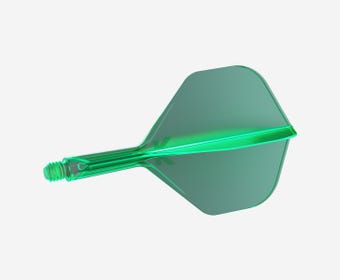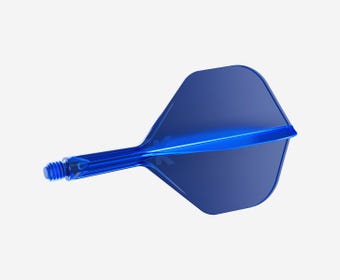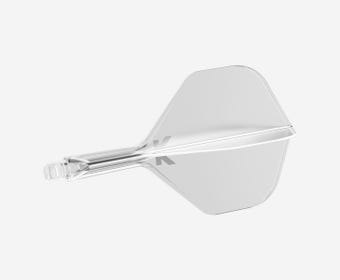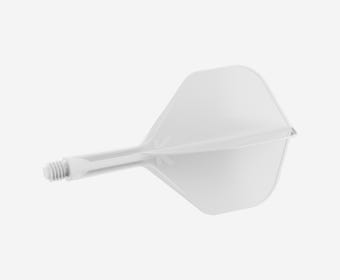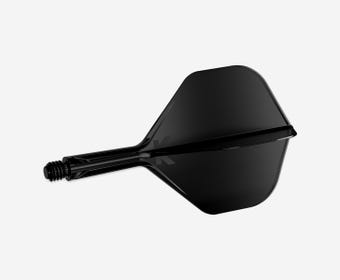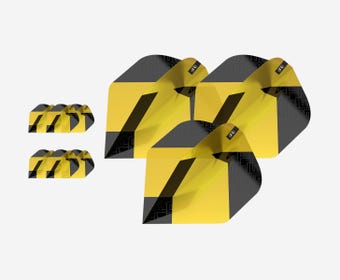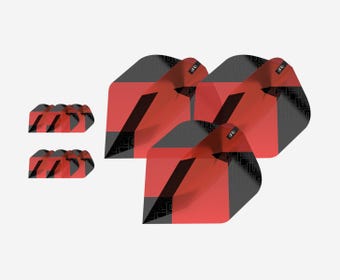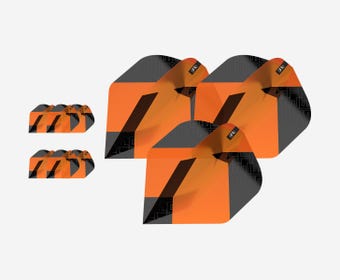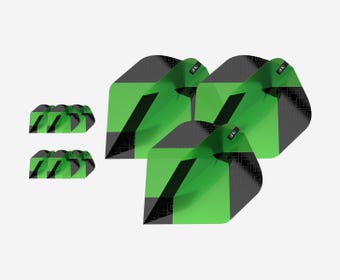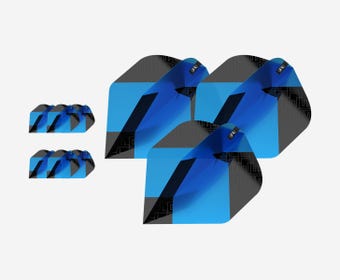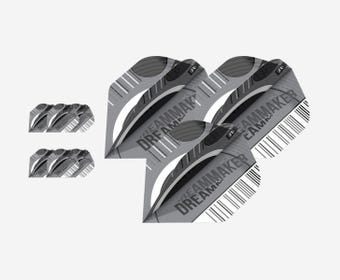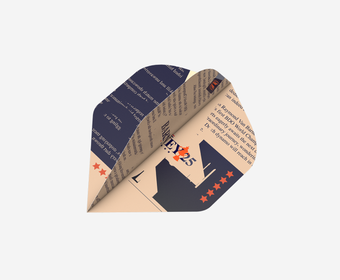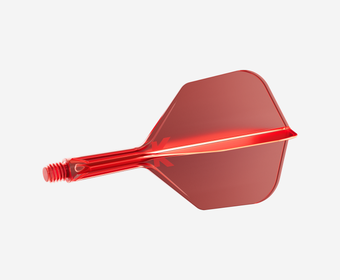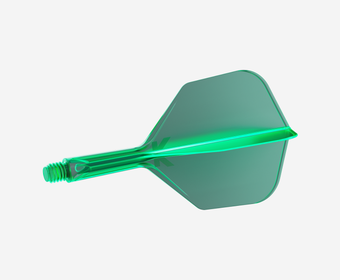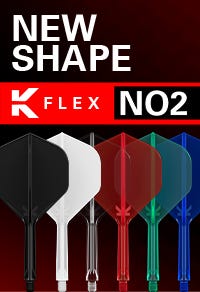

What size dart flight should I use?
Flights come in different shapes and sizes, and each one can have a unique effect on the flight of the dart. One important aspect of the game that can affect your play, but generally isn’t one of the first things people think to check, is the shape of your darts flights. In this blog post, we will explore the different shapes of darts flights and their characteristics that could help you with your game.
Standard Shape Flights (No.2/No.6/Ten-X)
The standard shape is the most common type of dart flight, normally available in either a No.2 or No.6. It is a hexagonal shape with a pointed base and a wider tip. The standard shape is ideal for players who prefer a smoother, more controlled throw. The wider tip of the flight provides stability, while the pointed tip reduces drag, allowing the dart to glide through the air.
The difference between the No.2, No.6 and Ten-X flights are their size. The No.6 are the standard size and shape that come with most darts, however players like Dimitri Van den Bergh and Katie Sheldon opt for the No.2. This is a slightly wider variation, which slows the dart down through the air. The Ten-X is the smaller brother of the No.6 flight which does the opposite of the No.2, with a smaller surface are and less drag, it moves through the air at a faster speed.
The standard shape is the most common type of dart flight, normally available in either a No.2 or No.6. It is a hexagonal shape with a pointed base and a wider tip. The standard shape is ideal for players who prefer a smoother, more controlled throw. The wider tip of the flight provides stability, while the pointed tip reduces drag, allowing the dart to glide through the air.


Standard Shape Flights (No.2/No.6/Ten-X)
The standard shape is the most common type of dart flight, normally available in either a No.2 or No.6. It is a hexagonal shape with a pointed base and a wider tip. The standard shape is ideal for players who prefer a smoother, more controlled throw. The wider tip of the flight provides stability, while the pointed tip reduces drag, allowing the dart to glide through the air.
The difference between the No.2, No.6 and Ten-X flights are their size. The No.6 are the standard size and shape that come with most darts, however players like Dimitri Van den Bergh and Katie Sheldon opt for the No.2. This is a slightly wider variation, which slows the dart down through the air. The Ten-X is the smaller brother of the No.6 flight which does the opposite of the No.2, with a smaller surface are and less drag, it moves through the air at a faster speed.
The difference between the No.2, No.6 and Ten-X flights are their size. The No.6 are the standard size and shape that come with most darts, however players like Dimitri Van den Bergh and Katie Sheldon opt for the No.2. This is a slightly wider variation, which slows the dart down through the air. The Ten-X is the smaller brother of the No.6 flight which does the opposite of the No.2, with a smaller surface are and less drag, it moves through the air at a faster speed.


Should I use the standard shape flights?
If you consider yourself to have a traditional, smooth throw or you’re just starting out and looking to find your feet, then this could be a suitable flight shape for you.
Which players use this shape?
Notably, this shape flight is used by the majority of professional players, including Dimitri Van den Bergh (No.2), Raymond van Barneveld (No.2) and ‘Voltage’ Rob Cross (No.6).
Which players use this shape?
Notably, this shape flight is used by the majority of professional players, including Dimitri Van den Bergh (No.2), Raymond van Barneveld (No.2) and ‘Voltage’ Rob Cross (No.6).
Slim Shape Flights
Slim shape flights are a smaller and narrower option for flights. They are designed for players with a faster, more aggressive throw. Due to their decreased surface area and boxy shape, slim flights create less drag, allowing the dart to travel faster and with less air resistance. They are also ideal for players who have a more compact throwing action.
Should I use slim shape flights?
If you throw the dart with a lot of power and don’t loop the dart onto the board, a slim flight will help to cut out wind resistance and speed up the dart through the air.
Kite Shape Flights
Kite flights have a unique shape that resembles that of a kite. They have a wider top and a narrower bottom, providing a larger surface area for the air to pass over. This results in a slower, more stable flight, making them ideal for players who want more control over their throw through the air.
These are generally designed for players that take a more technical approach to their game, with a focus on releasing the dart at the right angle at the right time and speed, even more so than normal.
Should I use kite shape flights?
If you have a very technically minded throw, with a focus on the minor details whilst maintaining a slow speed across the flight of the dart, then this could be the shape for you.
Pear Shape Flights
Pear shape flights are wider at the top and narrower at the bottom, resembling a pear. They provide a more refined surface area for the air to pass over, resulting in a quicker, more direct flight. Pear shape flights are ideal for players who have a slower throwing action and want more control over the dart's trajectory.
This particular flight is used by the legendary Glen ‘Duzza’ Durrant. When asked about why he uses this shape he said: “I find that a pear shaped flight cuts through the air and reaches the dartboard quicker. It doesn’t deviate much in the air so it’s much more consistent.”
Should I use pear shaped flights?
If you’re someone that likes to see the dart reach the board quicker than your average flight, then you should consider using a pear shaped flight. They reduce air resistance and cut through the air much more aerodynamically than the traditional No.6 or No.2.
Pear shape flights are wider at the top and narrower at the bottom, resembling a pear. They provide a more refined surface area for the air to pass over, resulting in a quicker, more direct flight. Pear shape flights are ideal for players who have a slower throwing action and want more control over the dart's trajectory.
This particular flight is used by the legendary Glen ‘Duzza’ Durrant. When asked about why he uses this shape he said: “I find that a pear shaped flight cuts through the air and reaches the dartboard quicker. It doesn’t deviate much in the air so it’s much more consistent.”


Pear Shape Flights
Pear shape flights are wider at the top and narrower at the bottom, resembling a pear. They provide a more refined surface area for the air to pass over, resulting in a quicker, more direct flight. Pear shape flights are ideal for players who have a slower throwing action and want more control over the dart's trajectory.
This particular flight is used by the legendary Glen ‘Duzza’ Durrant. When asked about why he uses this shape he said: “I find that a pear shaped flight cuts through the air and reaches the dartboard quicker. It doesn’t deviate much in the air so it’s much more consistent.”
Should I use pear shaped flights?
If you’re someone that likes to see the dart reach the board quicker than your average flight, then you should consider using a pear shaped flight. They reduce air resistance and cut through the air much more aerodynamically than the traditional No.6 or No.2.
Should I use pear shaped flights?
If you’re someone that likes to see the dart reach the board quicker than your average flight, then you should consider using a pear shaped flight. They reduce air resistance and cut through the air much more aerodynamically than the traditional No.6 or No.2.


Target Vapor Flights
Vapor shape flights are similar to kite shape flights, but with a more streamlined shape. They were specifically designed for 16x World Champion Phil Taylor as he wanted something smaller and more aerodynamic to suit his barrel shape and style. They are wider at the top and taper to a narrow point at the bottom. This shape reduces drag and provides a lightning quick throw, making them ideal for players who want a much more controlled throw.
It’s worth noting that these flights are still significantly smaller than the traditional flight shape, so make sure you test them against your throw before you go out and enter a tournament with them!
The original vapor shaped flights are still in use by Keane Barry, who pairs them with white intermediate Pro Grip shafts. This is a setup that allows him to stack the darts on the board, with the flight sitting lower than the point when it hits the board. He likes that this shows him more space in the bed that he can aim for over the top of his last dart.
Vapor shape flights are similar to kite shape flights, but with a more streamlined shape. They were specifically designed for 16x World Champion Phil Taylor as he wanted something smaller and more aerodynamic to suit his barrel shape and style. They are wider at the top and taper to a narrow point at the bottom. This shape reduces drag and provides a lightning quick throw, making them ideal for players who want a much more controlled throw.
It’s worth noting that these flights are still significantly smaller than the traditional flight shape, so make sure you test them against your throw before you go out and enter a tournament with them!
The original vapor shaped flights are still in use by Keane Barry, who pairs them with white intermediate Pro Grip shafts. This is a setup that allows him to stack the darts on the board, with the flight sitting lower than the point when it hits the board. He likes that this shows him more space in the bed that he can aim for over the top of his last dart.
After success with the vapor, Phil Taylor took it one step further with the creation of the Vapor S flights. These are the same width across at the widest point except they taper off much quicker and have a sharper point to them, making them even shorter than before.
Should I use vapor flights?
If you know your throw is capable of keeping the dart stable enough through the air and you want a fast result, then vapor flights would be a great option. They also enter the board at a much lower angle traditionally so you will be able to see over the darts at how much space you have remaining in the bed.
After success with the vapor, Phil Taylor took it one step further with the creation of the Vapor S flights. These are the same width across at the widest point except they taper off much quicker and have a sharper point to them, making them even shorter than before.


After success with the vapor, Phil Taylor took it one step further with the creation of the Vapor S flights. These are the same width across at the widest point except they taper off much quicker and have a sharper point to them, making them even shorter than before.
Should I use vapor flights?
If you know your throw is capable of keeping the dart stable enough through the air and you want a fast result, then vapor flights would be a great option. They also enter the board at a much lower angle traditionally so you will be able to see over the darts at how much space you have remaining in the bed.
Should I use vapor flights?
If you know your throw is capable of keeping the dart stable enough through the air and you want a fast result, then vapor flights would be a great option. They also enter the board at a much lower angle traditionally so you will be able to see over the darts at how much space you have remaining in the bed.
What shape flights should I use?
The shape of darts flights plays a significant role in the flight of the dart. Players should experiment with different shapes and sizes to find the flight that best suits their throwing style. Whether you prefer a slower, more controlled throw or a fast, aggressive throw, there is a dart flight shape that can help you achieve your desired trajectory.
You should also consider the length of your selected shaft into your darts set up. If you’re after a more controlled slower flight, perhaps it’s worth considering a longer shaft paired with a No.2 flight to increase the air resistance and drag so it slows up in the air. You also need to think about how you want the darts to sit in the board once they’ve been thrown.











